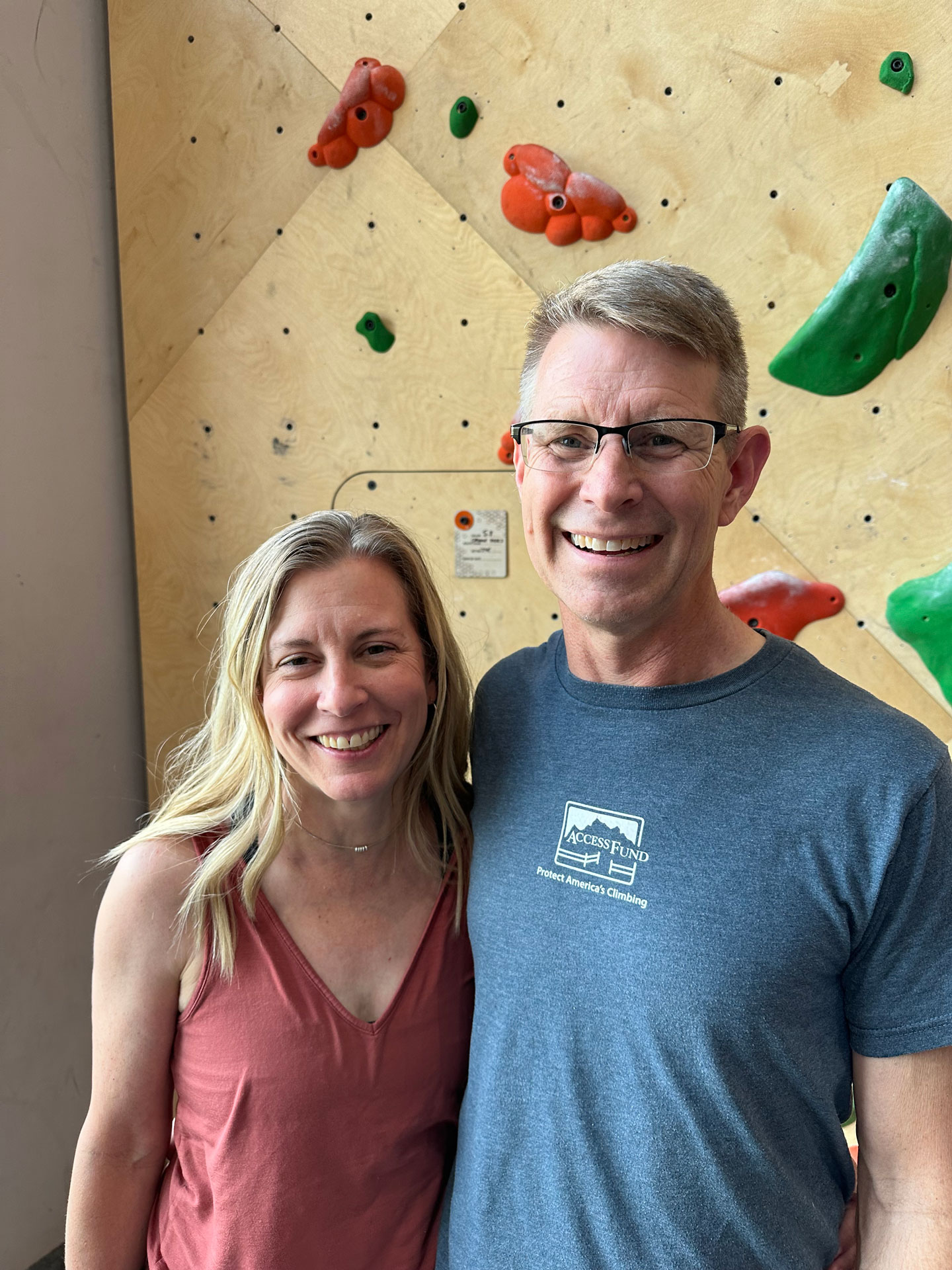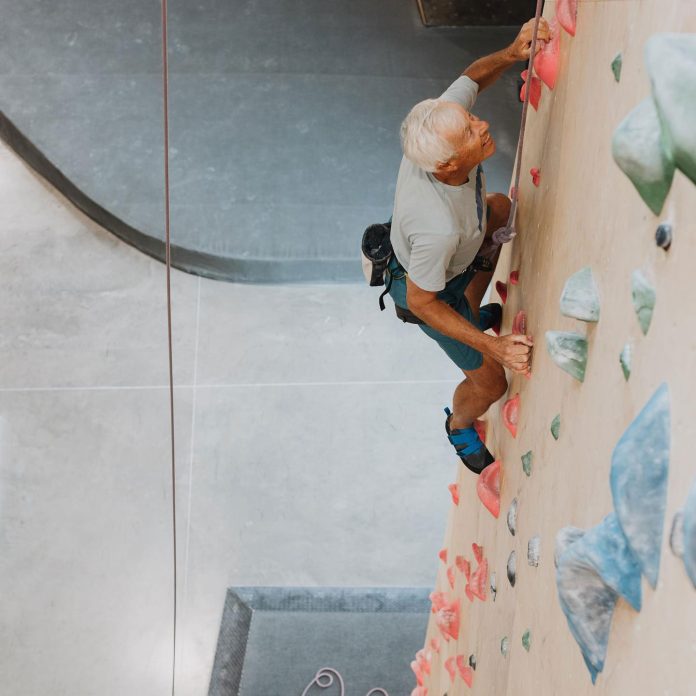
The Huntsman World Senior Games is a massive, multi-sport event that takes place in St. George, Utah, every year. Inviting athletes 50 years and older to participate and compete, the Senior Games is—according to the Games’ website—“dedicated to being the world leader in active aging.”
For the first time ever, this year’s Senior Games, which runs from October 7-19, will feature climbing, with age categories including 50+, 55+, 60+ 65+, 70+, 75+, 80+, 85+, 90+, 95+ and 100+. The climbing events will take place at Contact Climbing Gyn, in St. George. (Editor’s Note: Registration is currently open for anyone wanting to participate; the final registration deadline is September 1; additional details can be found here. If any gym wants to help advertise the Senior Games, this flyer—which also includes a QR Code with additional information—can be printed and posted on windows, near the front desk, etc.)
Climbing Business Journal caught up with Contact Climbing’s founder, Jeff Compas, who with his wife, Jenny, were largely responsible for climbing’s inclusion in the Senior Games.
CBJ: Tell me more about the process of getting climbing included in the Senior Games.
COMPAS: The Senior Games are a pretty big deal in town, and it’s kind of hard to miss it when it’s happening. I enjoy running and cycling, and I have friends who compete in the Games. I have considered competing myself—I’m 57—but I am not a really strong cyclist or runner, and I really love climbing the best and thought that it would be great if climbing was an event.

So, I called up the headquarters of the Senior Games and asked who I should talk with to see if we could arrange to host a climbing event at Contact Climbing. I spoke with John Rosander, who has been the director of sports for the Senior Games for many years. He invited me to come and pitch to their committee. Excited about the prospects, my wife and I put together a presentation with some pictures of senior athletes crushing it outdoors. We showed competition footage of Olympic athletes. We had some pretty good pictures of some of our more senior members at Contact, and we talked about how we envisioned that we could adapt these events to better suit aging athletes (i.e., no bouldering—potential for joint and bone injuries is much higher in that population).
The committee enjoyed the presentation, but they were skeptical that we’d be able to get people to travel to St. George specifically to participate in a climbing event. I told them I’d do all the heavy lifting, including reaching out to contacts in the climbing industry. I’d organize the event and donate the use of the gym space and the routesetting time. To try to get more support from the community, I did an informal survey on the Climbing Gym Operator Facebook group asking if other gym owners would support us and help advertise, and if they thought their community would participate. I reached out personally to gym owners that I know, and the response was overwhelmingly positive. Armed with a little more evidence, I went back to the Senior Games [staff] and shared with them the work I’d done. In the meantime, they had been conversing with people and doing a little research on the sport and they were pretty excited about it. They agreed to give it a go.

What were some of the challenges amid that whole process?
We haven’t really encountered what I would call challenges, though it will be very interesting to see how many people actually participate. There is a big difference between people saying, “Yeah! That sounds awesome!” to actually getting on a plane and coming to St. George, Utah, or driving here from Salt Lake City or Las Vegas.
We do have a thriving community of retired people in St. George—and we have a number of very strong climbers who are 50+. The trick will be getting them all out. I still think there is much work to be done in a short time to generate interest between now and October. It’s my hope to have more than 50 people participate, but we might end up with 15 or 20. Just as easily, we could end up with 100 or more—it will depend, I think, on if someone in each of those communities latches on and gets their friends to participate.

Do you feel like seniors are an underserved community in the climbing industry? Is there anything that you wish the industry would do to cater to that particular demographic?
Under-represented, perhaps. I don’t know that gyms really need to do anything special to serve that population better. Climbing is very gentle and is a great full-body workout. It’s easy on your joints (if you’re on ropes) and is great for you mentally, as well as physically. Most gyms are conscientious about setting routes that provide a wide range of difficulty for climbers no matter where they are in the spectrum, and this [intentionality] serves aging athletes well. Climbing gym communities are generally very welcoming and provide a great place for people of all ages to make friends.
The barrier to entry into the sport seems to be mostly unawareness or intimidation. I would bet most seniors have acquaintance with climbing because they saw Free Solo or caught glimpses of Janja Garnbret performing feats of superhuman gymnastic ability. They don’t identify with those things at all. So, if there’s something that we need to do as an industry, it would be mostly around education and awareness that climbing is for everyone, and maybe even especially for aging, active people who want to participate in an engaging, community-focused sport. I’m still trying to crack that nut in our community—I think the potential is great.

Are you going to compete at the Senior Games?
I am going to compete, but I’ll probably do a cycling or triathlon event. In order to get all the routes done that we’ll need for the event, I’ll be routesetting with the team. Usually, when you set the routes, it’s kind of not fair to compete in the event. I guess I could compete in the speed event. But it takes me, like, seven minutes to get to the top of that thing.

John Burgman is the author of High Drama, a book that chronicles the history of American competition climbing. He is a Fulbright journalism grant recipient and a former magazine editor. He holds a master’s degree from New York University and bachelor’s degree from Miami University. In addition to writing, he coaches a youth bouldering team. Follow him on Twitter @John_Burgman and Instagram @jbclimbs. Read our interview Meet John Burgman, U.S. Comp Climbing’s Top Journalist.









